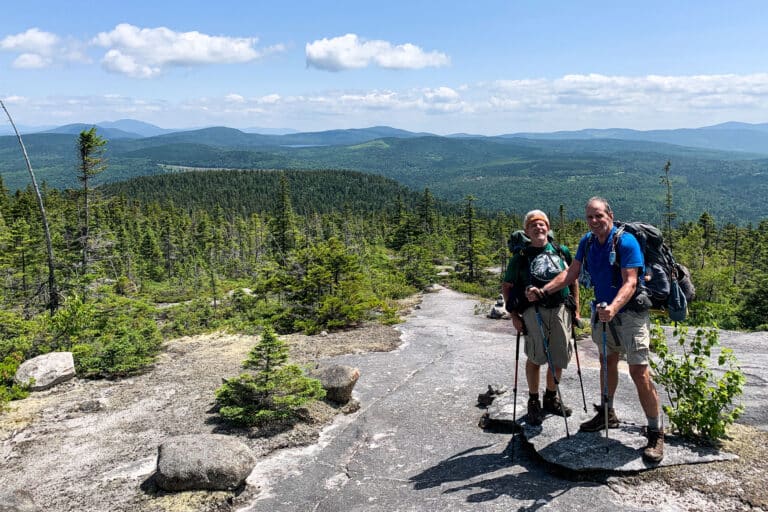Alan Cameron climbed a rocky bank above a gravel road, shined his pocket-sized flashlight into a crevice and uttered a phrase he would repeat again and again on this, one of the more recent of his dozen-plus year’s worth of salamander-spotting excursions: “There’s a green.” He pointed to a creature that, without the glimmer of the beam off its moist skin, would have been invisible in these surroundings: only 5 inches long with a flat build that allows it to squeeze into narrow cracks, with background coloring that matches the brown of shaded rock, with gold-green blotches that mimic patches of lichen and moss.
“You can see how it blends in,” said Cameron, 73. “Green salamanders spend most of the year in these rocks. They have to have crevices. It has to be shaded. The moss indicates good humidity and they have to have high humidity.”
Cameron’s tireless volunteer work monitoring green salamanders (Aneides aeneus) helped lead to what, for him, was an unwelcome result — last year’s downlisting to threatened of what had long been the only salamander species designated as endangered by the state. But Cameron has also helped lay the foundation for research that might eventually restore the green’s status as endangered.
In the general sense of the term, the green surely is endangered, he said, and that’s bad news all around because healthy green habitat is pretty much synonymous with a healthy Appalachian landscape. Bulldoze rocks and greens are gone. Clear rhododendron and they lose life-giving shade. Destroy forest canopy and their summer homes are razed. Allow invasive wooly adelgids to spread, killing stands of hemlock, and greens retreat. In fact, green salamanders and their kin are so closely tied our image of Eastern mountains that the most famous chronicler of this region, Barbara Kingsolver, “said ‘salamanders should be on the state flag of the Appalachians,’” according to leading amphibian researcher J.J. Apodaca.
The green’s preferred environment is also Cameron’s. After retiring from the National Security Agency, he moved from Maryland to Western North Carolina in 2004, unwittingly placing himself between the state’s two documented groups of greens, one centered in the Isothermal region to the east of his home and the other in the Blue Ridge Escarpment, to the west. After he volunteered his services to the state Wildlife Resources Commission, his location made him a natural to monitor greens. And his energy, organizational skills and general love of wildlife — including the exotic varieties he saw on NSA postings in Thailand and Vietnam — led him to become a citizen scientist on speed and steroids.
Weather permitting, he spends six days a week looking for greens and, in recent years, timber rattlesnakes and spotted skunks. He has monitored more known green habitat and discovered more new habitat — by far — than any scientist in the state, said Lori Williams, a WRC biologist who supervises his work. Because full-time scientists are often bound to their desks, “we could never cover the ground that Alan covers,” she said. “He’s been so devoted and he spends the majority of his year in the field . . . We have a lot more dots on the map (marking green habitat) than we would ever have without Alan.”
No surprise, then, that Cameron and his data are at the center of two biggest developments in the world of greens — both the recent downlisting and Apodaca’s research showing the state’s two populations are far more distinct than previously believed, “separated by 14 miles and 11 million years,” Apodaca said.
The change in the green’s protection status was based on a Wildlife Commission recommendation at a meeting in February of 2017. It was an appropriate action, Williams said, because listing decisions are data-driven and Cameron’s work and improved mapping tools have increased the number of known green dwelling places from about 100 to more than 1,000 in the past 15 years. Despite the downlisting, state law maintains the same restrictions on uses of public land that could harm greens and the same prohibitions on killing or collecting them. She also emphasized, for the benefit of landowners who might hesitate to report greens on their lots, that the new status leaves the same limits on the development of private property — none at all. “Thirty years ago, when these protection acts were written, private landowners and their property rights were very much at the forefront,” she said.
Cameron initially opposed the downlisting because of the lingering effects of the mysterious mass die-off that led to the green’s designation as endangered in 1987. In the 1970s and ‘80s, about 98 percent of the green population disappeared, maybe because of acid rain or air pollution. But even after air and rainfall quality improved, individual populations never rebounded. An outcropping near Lake Lure, for example, once harbored as many as 15 greens. “Now, I’m lucky to see one,” Cameron said. “I was ready to go to the (Commission) meeting and yell bloody murder.” He was talked out of it, he said, partly because he believes the salamanders will regain endangered status once Apodaca’s work “hits the streets.” Instead of being considered one species with a growing documented range, greens in North Carolina will be seen as two smaller groups. “Not only will greens be listed as endangered, so will (Isothermal) salamanders,” Cameron said.
It’s too soon to say that, said Apodaca, associate executive director of the non-profit Amphibian and Reptile Conservancy, who cautioned that his research is still being reviewed. But genetic analysis clearly indicates the Isothermal “population has a unique lineage.” It was the seed population, he said, and spread to the northern edge of the green’s range in southern Ohio and Pennsylvania, then back south through the mountains of Kentucky and Tennessee before finally reaching the Escarpment. This is separated from the Isothermal region by a valley where green migration is currently blocked by Interstate 26 and where movement was impeded for millions of years before the road’s construction by the flat landscape, devoid of rock outcroppings.
Apodaca and Cameron do agree, however, that Cameron was crucial in mapping the range of these populations. ”I’m the guy who found the two sites (of the separate groups) that are closest to each other,” Cameron said. “Without Alan,” Apodaca said, “we would have a much blurrier picture of where these animals live.”
They also agree on the obvious point that greens and many other salamanders remain highly vulnerable. Globally “a little over 50 percent of the species are considered threatened on some level,” Apodaca said. It’s almost a rule of thumb that actions advancing human populations end up harming salamanders. Residential development, of course, clears habitat. So does farming, which also spreads chemicals that are hazardous to all salamanders and that are especially deadly to greens and other lungless species, which breathe through their thin, porous skin. Roads can be even more lethal, creating fragmented habitat and brutal gauntlets that can kill more than half the salamanders — never known as great migrators — that try to cross them, according to the nonprofit Save the Salamanders. And the green’s brilliant coloring and prominent “puppy-dog eyes,” as one researcher described them, create another hazard — appeal to collectors. Scientists recently noted the ominous sight of a screwdriver wedged in a Jackson County rock known for sheltering the species. Williams called it “indirect evidence of pet collection.”
So, as Cameron sees it, greens need somebody to stand up for them. “They lived in our forests for millions of years before humans ever set foot on this continent,” he said. “I think that gives them the right to continue to exist here.” During an outing last October in Dupont State Forest, he quickly left the road and sought out salamanders the way he usually does, by bushwhacking. It’s an activity he is built for — compact and slim, a former champion age-group distance runner — the way salamanders are built to hide in rocks. He found them, one after another, and marked their location in a pad he carried the back pocket of his blue jeans. His miniature MagLite was tucked in the other pocket, and two cameras rode in holsters on his hips.
Though he says he’s “not smart enough to analyze the data; I just collect it,” his work has amounted to far more than adding dots to maps. He has observed females descend from their summer homes in the treetops to lay eggs that are suspended — “like bunches of grapes,” he said — from the roofs of crevices. He has watched embryos develop in eggs as clear as snow globes, eyes first appearing as black specks, dark bodies expanding as yoke recedes, dime-sized versions of adults emerging and leaving brood crevices to meet who knows what fate. Only one scientist had previously recorded a sighting of a mutant flesh-colored green salamander before 2011; that year Cameron photographed two of them.
He is the first person to document an apparent delay in some juveniles’ production of yellow pigment, which temporarily leaves their trademark green markings bright blue. And recently he has taken on the job of collecting swabs from salamanders’ skin so scientists can check them for pathogens.
In the field that afternoon, he blocked one green’s escape route with twigs and prodded its tail with a blunt-tipped wire until it landed at his feet with a barely audible rustle of a leaf. “Sometimes they do that. They just jump,” he said. He rubbed its skin with a swab, measured its length (4.7 inches) with calipers and its weight (2.7 grams) on a tiny scale. He then returned it to the rock and watched it scurry back into its crevice, where it looked as fully at home as Cameron was with his notepad and camera — far from the road and deep in the forest, in among the lichen and the moss, the rocks and the salamanders.








